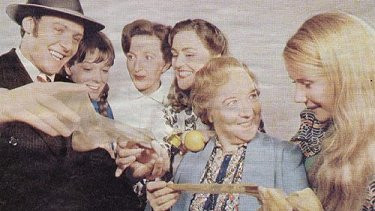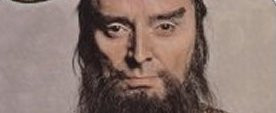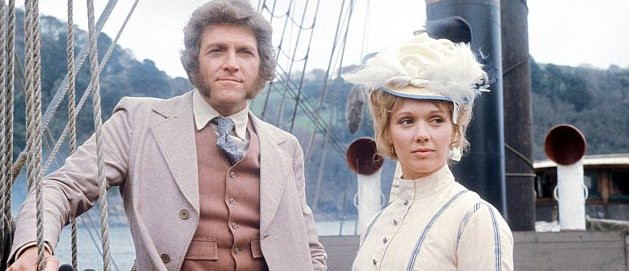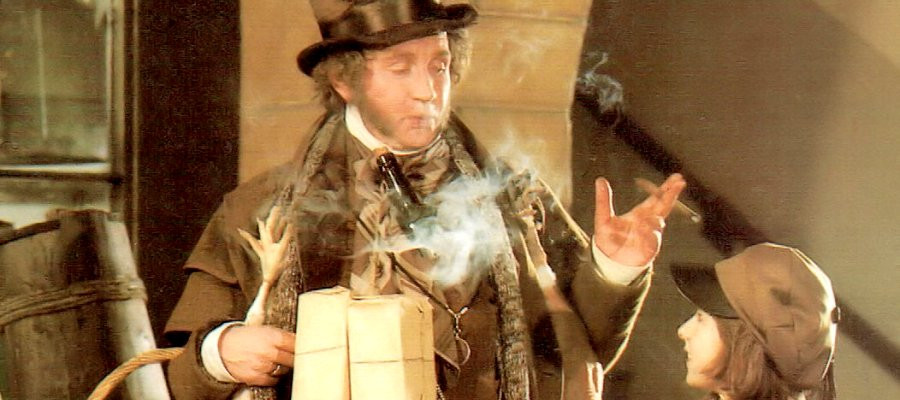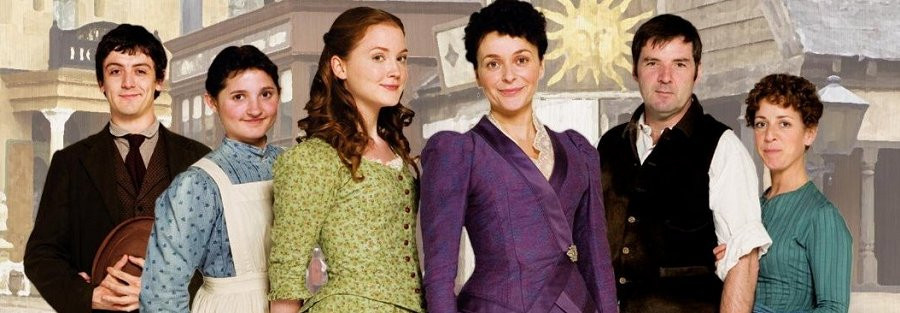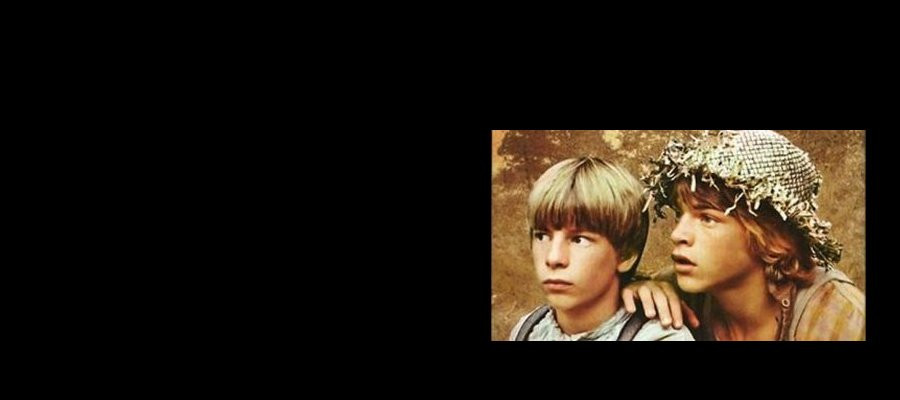
Huckleberry Finn and His Friends
Mark Twain's Adventures of Huckleberry Finn (1884) is standard fare on the reading lists of American Literature survey courses which are often compulsory, particularly in North American English Departments. The book is often taught alongside essays and books such as Ralph Waldo Emerson's 'Self-Reliance' (1841) and Henry David Thoreau's Walden; or, Life in the Woods (1854) which involved a retreat into nature. Twain's book espouses the Emersonian ideal where the innocent American, Huckleberry Finn, finds life on the shore smothering and finds freedom on the river aboard a raft with runaway slave Jim. As such, Twain's book can be seen as a precursor to the twentieth century 'buddy' road movie which not only involves a geographic journey across spaces but also a voyage of self-discovery. Film and television adaptations often highlight this and the dramatizations of Twain's novel might be seen by some as making the book more accessible. Scholars like H. Bentley (1996) and before him, George Linden (1971) and Charles Eidsvik (1977), for example, assess adaptations in terms of usefulness in encouraging school students to read the source novel. Twain's novel is also often taught on more advanced courses alongside his other works such as his novels A Connecticut Yankee in King Arthur's Court (1889) and Pudd'nhead Wilson (1894); the second of these books, for instance, again deals partly with the theme of slavery and of nature and nurture where two babies, white and black, are switched at birth and raised as the opposite.
Huckleberry Finn and His Friends was a 1979 Canadian/German co-production. The serial came one year after the 26-part serial Heidi, based on the book by Johanna Spyri (1881) which was made for the German market. As revealed in the DVD documentary The Making of Mark Twain's Huckleberry Finn and His Friends, for budgetary reasons the Huckleberry Finn serial was filmed in Canada, with the Fraser River in British Columbia acting for the Mississippi, as well as a set having been built for the town, while the cast was composed of (mostly) Canadian and German performers. The serial was made to appeal to the English-speaking market. In the documentary, executive producer Tom Wagner states that prior to Huckleberry Finn and His Friends both Mark Twain books, The Adventures of Tom Sawyer (1876) and Adventures of Huckleberry Finn, had never been produced together and so it was a new situation for both to be placed in one serial. The opening titles read 'Mark Twain's Huckleberry Finn and His Friends', acknowledging the author, and this article shall probe how the serial unifies the novels in other ways than just through the title.
Looking at adaptations of the classic British novel, Sarah Cardwell (2002) points out that 'Adaptations have, perhaps more consistently than other films and television programmes, been…subject to criticism…and evaluation…according to…criteria such as fidelity to the source novel' as well as to 'ideological or political correctness' (206). Cardwell opposes the idea touched upon in my Introduction that the purpose of the adaptation should be educational and send new readers to the book (38-9) and also argues that each of the adaptations considered in her book 'needs no input from a viewer with knowledge of the source novel' (208). In his more recent book on screen adaptations of Agatha Christie's works, Mark Aldridge (2016) similarly argues against a dismissive approach that one can only be a fan having experienced the original (1). However, Aldridge does advocate that one should at least try reading some of Christie's books (1) and looks at how adaptations dealt with the source material (2). Aldridge indicates that, throughout his tome, the recurrent themes of the battle between fidelity to the source and perceived popular appeal will be apparent and, significantly, he evaluates some screen adaptations (3). The approach in this article is not to make value judgements about Huckleberry Finn and His Friends and the various Tom Sawyer and Huckleberry Finn films based on the extent of their fidelity to Twain's books or to contend that, in coming to this serial, the viewer must have knowledge of the source novels or even must go to them afterwards. It is also not essential that a comparative method of analysis be made. However, as well as looking at the techniques of television used to give the serial a unified style, there is still space for investigating what changes were made from the books and the films, what was kept from the books in contrast to the films, and what was modified from just one book in contrast with the films, in order to incorporate both books in this one serial, an ongoing form of television. In the DVD documentary, it is mentioned that the serial is authentic to Twain's books. This comment is made in relation to sets and while the costumes, characters, plot and some of the speech (with the children using terms like 'bully' to mean 'great') are also authentic, there are some significant changes.
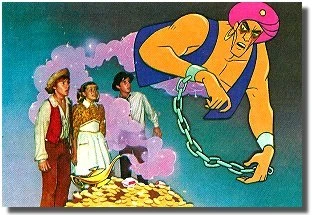
Prior to Huckleberry Finn and His Friends, however, was the Hanna-Barbera 20-part colour serial The New Adventures of Huckleberry Finn which was not an adaptation and ran a decade earlier on NBC from September 15 1968 to February 23 1969 and was repeated as part of The Banana Splits and Friends Show. The first episode began with Tom's Aunt Polly and Becky's mother distressed that the children were late arriving home and each episode commenced with a 'prologue' where Huck revealed that he, Tom and Becky made their way through the same graveyard, as a short-cut on their way home, where, as in the first Tom Sawyer book, Huck and Tom had witnessed Injun Joe kill Doc Robinson and that here Injun Joe (Ted Cassidy) was out to get the pair for having exposed him in court. But, as the title with the words New Adventures suggests, that is where any direct similarity with Twain's books ends and the live action heroes of Huck (Michael Shea), Tom (Kevin Schultz) and Becky (Lu Ann Haslam) are plunged into a world of animation where they face a different adventure in each episode and murderous villains, all sharing the same face of Injun Joe. The series was the first weekly one to combine live action and animation.
As is the case with television programmes generally, the title sequence of Huckleberry Finn and His Friends tells the viewer what to expect. In this case, the serial opens with a song by Paul Wilson. The song is lyrical and marks the serial as taking the television viewer back to an earlier age and is nostalgic for this time ('Try looking back more on days that were slower/When livin' came easy and neighbours were friends' and 'That's where they came from,/The time that they came from,/No better time to live and to grow, Oh,/That's where they came from,/The days that they came from,/Life was so carefree - not so long ago') . Cardwell argues that the mood of nostalgia is key to the adaptation of the classic British novel and examines the techniques used to achieve such feelings. The opening song further codes the serial as participating in the adventure genre featuring children ('…as kids on the river/Went seeking adventure or some pirate's den'). However, as well as marking the mood and genre of the serial, the song opens all 26 episodes and therefore gives the programme a uniform style.
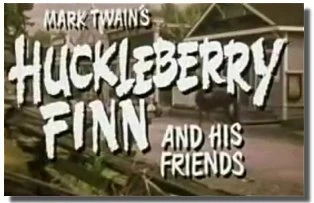
The titles do something else to marking the serial generically. Ian Tracey is the only actor to appear consistently in all 26 episodes of the serial and the titles bill him first of all as star: alongside an image of Huck fishing there is the caption 'starring Ian Tracey as Huckleberry Finn'. By having Sammy Snyders' name as Tom Sawyer after Ian Tracey's, in the episodes which do not feature Snyders, he is easily replaced by Blu Mankuma, playing another of Huck's friends, Jim, with Mankuma's name laid over a shot of Jim by a camp fire. Mankuma's name, however, comes after Snyders' in the episodes in which they both appear, some of which are adapted from the second book. Tracey, though, provides continuity throughout the serial while Snyders provides some uniformity. Actors playing other of Huckleberry Finn's fellow travellers are billed in the opening credits after Mankuma: 'Heinz Schimmelpfennig as the Duke' and 'Joseph Golland as the Dauphin'. Meanwhile, 'Dinah Hinz as Aunt Sally' appears in several episodes at the end and is billed before the Duke and Dauphin performers, or at the conclusion. She takes a role similar to co-star 'Brigitte Horney as Aunt Polly' who appears in the early episodes based on the Tom Sawyer and Huckleberry Finn books, is billed at the end of the title sequence, and also offers some continuity. This is also the case in the final episode where both Horney and Hinz appear, with Horney billed before Hinz.
The shots in the opening title sequence also provide a uniform style to the serial. Throughout the serial, the title sequence begins with a shot of the river and of a steam boat and after the title appears on screen, there are, throughout all 26 episodes, shots of Huck and Tom strolling across the town street and along in the woods providing a unified style, even though there are changes. For in the episodes in which Tom Sawyer appears, the title sequence ends with the two boys racing away in a carefree manner, while in the episodes which feature only Huck and Jim, there are shots from the serial of Huck riding a horse and also, where the Duke, the Dauphin and Aunt Sally are not credited, of Huck and Jim dancing around in an elated manner at having found one another, of the two conversing, and, in all cases, of them aboard the raft. But the changes in title sequence in the serial do not mark a clear division between the two books as Tom Sawyer appears in some later episodes too.
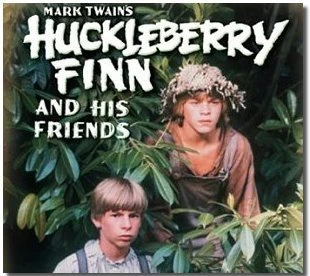
The character of Huck is given greater prominence in the early episodes of Huckleberry Finn and His Friends, unifying the two parts into one serial. For example, unlike in the Tom Sawyer book, in the serial Huck helps Tom get the remaining ticket so that he can claim a prize Bible. Furthermore, as in the book, in the 1938 Adventures of Tom Sawyer and in the 1973 Tom Sawyer Tom alone testifies at Muff Potter's trial revealing that it was Injun Joe who murdered Doc Robinson. In the films, Injun Joe throws a knife at Tom, which sticks in the chair of the stand narrowly missing the boy, before leaping through the glass of the courthouse window and later in the caves tries to avenge himself against Tom (for instance, in the 1973 film he yells 'I'm going to kill you Tom Sawyer. I'm going to kill you. You'll never get out of here alive'). However, in the Huckleberry Finn and His Friends episode 'Muff Potter's Trial'both Tom and Huck take the stand even though it is still Tom who shouts out that it was Injun Joe who killed Doc Robinson. Unlike in the other films, Injun Joe does not throw a knife at the stand but, without pause, and true to form, jumps through the glass window of the courthouse, leaving the constable to later warn Tom and Huck that Injun Joe will without doubt want revenge. Despite the plot alterations, the animated films would also involve Tom and Huck falling foul of Joe.
Adventures of Huckleberry Finn is a direct sequel to The Adventures of Tom Sawyer and both books therefore fit into the ongoing serial of Huckleberry Finn and His Friends. Adventures of Huckleberry Finn begins with Huck stating 'You don't know about me without you have read a book by the name of The Adventures of Tom Sawyer…That book was made by Mr. Mark Twain'. The characters (like Tom and Huck and even Aunt Polly and Sid and Judge Thatcher and the Widow Douglas) and plot of the first book are picked up in Adventures of Huckleberry Finn and contained in Huckleberry Finn and His Friends along with the recurring character of the town constable. There are omissions in the serial like the character of Tom Sawyer's cousin Mary. Also omitted from the first book is Tom's telling Aunt Polly about the dream he had of the family discussing the boys, presumed dead, when he had actually returned from playing pirates on a nearby island and spied on them, but this is not key to the flow of the serial. There is an interesting point to be made about the packaging of the books. In some cases, the books are sold separately yet in others the books, and indeed Tom Sawyer Abroad (1894) and Tom Sawyer, Detective (1896), are distributed by publishing houses under one cover, while there are also some unfinished works by Twain dealing with the Huck Finn and Tom Sawyer characters. Similarly, Huckleberry Finn and His Friends is packaged as one serial.

This serial, combining both books, differs from some of the films. Following the silent film treatments of Tom Sawyer, some of the Tom Sawyer films omit events from the book which lead to the sequel and which are in the serial, showing how these films are self-contained. The 1938 film The Adventures of Tom Sawyer, for example, concludes with Tom and Huck discovering the buried treasure, however Huck's rescuing the Widow Douglas from Injun Joe and being taken into her house as a hero is missed out. The Widow's attempts to civilise Huck partly provide the impetus for Huck's escape in the second book, along with his Pap's attempts to get his hands on the money from Judge Thatcher. The 1973 musical Tom Sawyer, by contrast, has the Widow Douglas stating early on to Aunt Polly that Huck is not bad but needs a strong influence, preparing for him later being taken into the Widow's home. But the film completely omits Tom and Huck finding the buried treasure which would lead to Pap returning to town and Huck making his getaway in the second book. The film ends with Huck already in his usual rags drifting along aboard a raft. Later films such as Storybook Classics' animated The Adventures of Tom Sawyer would alter events considerably where Injun Joe robs a steamboat and where Judge Thatcher pays a substantial reward to the boys but where the Widow Douglas strand of the narrative is left out. Additionally, MGM's animated Tom Sawyer not only sees Injun Joe murder the sheriff's deputy, as opposed to Doc Robinson, but, in this version, it is Tom and Becky who together find the treasure in the cave at the end.
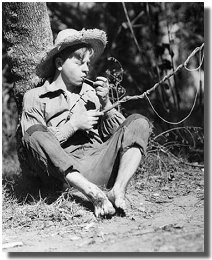
A further omission in some, but certainly not all, of the Huckleberry Finn films which illustrate how they are self-contained as opposed to being a direct sequel is the 'writing-out' of the Tom Sawyer character. This is the case, for instance, in the Mickey Rooney The Adventures of Huckleberry Finn. Here, following the 'King' and the 'Duke's' attempt to swindle the Wilks', Jim, who is suspected of murdering Huck, is taken back to stand trial and Captain Brandy of The River Queen gives Huck swift passage to prove that he is still alive before the townsfolk take the law into their own hands and lynch Jim. Therefore, the whole plot of Jim being kept imprisoned on the Phelps' ground and rescued by Tom and Huck, despite the fact that Jim had been freed in Miss Watson's will, is left out, as is Aunt Sally mistaking Huck for her nephew Tom Sawyer while Tom poses as his half-brother Sid. In Huckleberry Finn and His Friends, it's the Wilks plot which is omitted while the Phelps strand of the narrative, like the Grangerford one, is kept. In the film Huckleberry Finn, starring Jeff East, which is composed of musical numbers, Huck alone had freed Jim and the film had ended with Huck looking on from the shore as Jim departed on the raft to Cairo. Huck revealed that he would use his money to have Jim's wife and little girl sent on. In the later 1990s Walt Disney's The Adventures of Huck Finn, starring Elliah Wood, Huck's mother had died just prior to the opening of the film leaving the Widow Douglas and Miss Watson to take him into their home. Here, Huck's mother had bequeathed Huck money which his Pap is after. Towards the end of the film, Jim is kept at Phelps landing and it is revealed that Miss Watson had freed Jim in her will but there is no sign of Tom Sawyer. Some films, however, are sequels: the 2012 German film Die Abenteuer des Huck Finn, for instance, follows on from the 2011 Die Abenteuer des Tom Sawyer, with both starring Louis Hofmann and Leon Seidel. Tom Sawyer also appears in the later Ron Howard and Patrick Day films.
Also unifying the two books in this one serial is indeed the early appearance of Miss Watson's black slave Jim. Jim does not feature at all in Twain's The Adventures of Tom Sawyer but is rather introduced in the second chapter of Adventures of Huckleberry Finn. In the fourth episode of Huckleberry Finn and His Friends, 'Mystery at Midnight', still featuring events from the first book, however, Jim has a small role; working in the garden, he senses Tom creeping up behind him and he, Tom and Huck subsequently have a conversation about the different methods of curing warts before the children go to the graveyard and witness the murder of Doc Robinson. Jim's role as a runaway slave is pivotal in the second book by Twain, most of the Huckleberry Finn films, and the later episodes of Huckleberry Finn and His Friends, which, as noted above, involve Huck and Jim making their way along the Mississippi on a raft on the way to the free states. A film was made in 1955 which omitted the character of Jim completely, seeing Tom Sawyer helping Huck alone escape his Pap on a raft, and the main plot being the unsavoury characters of the 'King' and the 'Duke' trying to swindle the Wilks' with Mary Jane having earlier been a guest of the Widow Douglas and a love interest for Huck.
The two books are further unified into the one serial, Huckleberry Finn and His Friends, through the first-person narration of Huck in both the earlier and later episodes, again giving the character prominence. Cardwell argues that voice-over narration is a familiar convention of the adaptation of the British classic novel (167). There is precedent for the voice-over in Huckleberry Finn and His Friends since Twain's Adventures of Huckleberry Finnis narrated by Huck, and is an example of the vernacular being employed to give the book a regionalist identity, as indeed is the case in the later shorter books, Tom Sawyer Abroad and Tom Sawyer, Detective. The way the vernacular is used in Adventures of Huckleberry Finn has been raised by countless scholars and is surveyed by Sieglinde Lemke (2009). However, The Adventures of Tom Sawyeris not narrated by any character so we can see how licence has been taken in this television drama and here the prime effect of the narration is to provide a uniform style to the serial. This differs from films based on the second book where Huck narrates, and also instances where Mark Twain actually appears as a narrator, as opposed to just providing a voice-over. Such films include Huckleberry Finn, starring Ron Howard, where there are freezes of images to black and white, as in a story-book, and Tom Sawyer and Huckleberry Finn combining both books where Twain narrates to two children.
Not only does Huck narrate during episodes but there are also recaps by Huck at the beginning of each episode following the title sequence before the title of the episode appears on screen and a taster of things to come at the end of episodes by Ian Tracey before the end credits. Tracey acts as a host, bringing his charm to the proceedings, with his voice-over saying 'This is Ian Tracey, inviting you to join us next time…' or 'This is Ian Tracey. I hope you'll join us next time…' In these ways, Huck's narrative voice in Twain's book is highly suited to the television serial form since many American programmes begin with an omniscient narrator, or a character from the drama, stating 'Previously on…' or 'Last time on…' followed by naming the title of the programme and clips from the previous episode or episodes appearing. Moreover, American programmes typically end with a taster of things to come. These techniques then provide unification and gives the feeling of every episode being part of a serial. There is no identifiable shift between the first and second books in this serial, unlike in Adventures of Huckleberry Finn which begins with Huck telling the reader how the previous book wound up, as all episodes flow on from one another.
The books are further unified in the one serial through the use of consistent musical scores, by Ted Ottley. These take the form of more lively, jovial music, to more haunting scores, and, in all cases, give the mood of the different scenes. Music within episodes, like the title sequences and narration, provides a distinctive style. Television techniques are again important.
This article has focused on the English-speaking version of Huckleberry Finn and His Friends. It is worth making some concluding points, however. The subtitled versions keep many of the same techniques for giving the serial a uniform style and for unifying the two books. There is room, though, for considering the dubbing of the serial into foreign languages. For example, the foreign language title often incorporates the names of Tom Sawyer as well as Huckleberry Finn, and the title sequence song may be absent. But the tune, the arrangement of the cast, and the title sequence images remain. Further investigation is needed about the host's narration. Moreover, work remains to be done on the animated serial adaptations of Tom Sawyer and Huckleberry Finn. In one such animated serial, for example, where the title sequence song revolves around Huck Finn, and again reveals that events take place in the past ('before the Civil War in 1858'), Huck is the principal character who bravely leads the boys into the pirate's cave as the town is distracted by a fire, while a scared Tommy is resistant. In this serial, Becky Thatcher is romantically interested in Huck as opposed to being Tom Sawyer's love interest as in the book, films and other serials. Huck again provides narration over the course of the episodes in this serial, as is the case in Huckleberry Finn and His Friends. Evidently, as has been seen, each serial and film handles the source material in different ways.
I'd like to thank my uncle, Neville Brookes, a true film buff, for stimulating conversation about Huck Finn and for supporting me in writing this article.
Published on February 22nd, 2019. Written by Dr. Andrew O'Day (2017) for Television Heaven.



